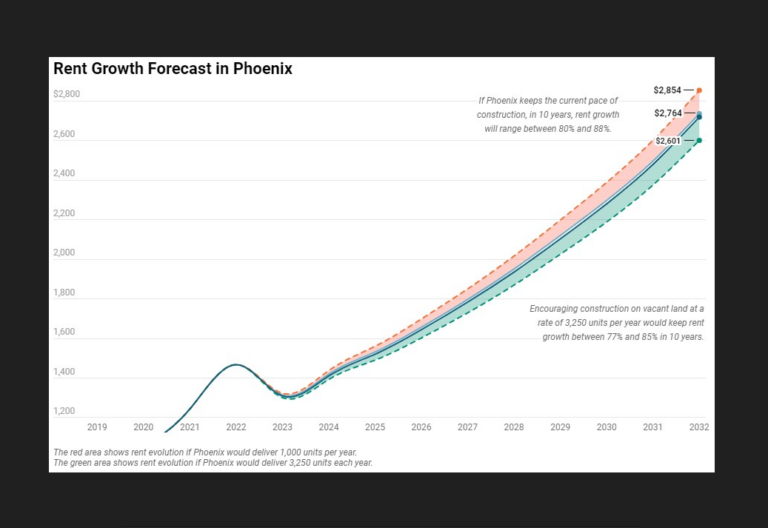By Alexandra Both and RentCafé
Phoenix is one the nation’s fastest-growing cities, having welcomed more than 30,000 newcomers in the last three years, all needing a place to live amidst an affordable housing shortage. According to Maricopa Association of Governments data, almost half of renters in Maricopa County are cost-burdened, paying more than 30% of their income on rent. As a result, since 2017, homelessness in Phoenix surged by more than 70% to an alarming 9,600 people at the start of the year.
More action is needed because Phoenix holds the key to its own housing crisis. The city ranked third nationally for undeveloped land. Apartments built on this empty land could house a whopping 93,000 renters, triple the number of new residents that the city welcomed in the last three years.
Phoenix has a staggering 36MSF of available land that is already zoned for multifamily, or 363 plots. All this space could be turned into residential communities with up to 32,500 apartments. That’s nearly 70% of all the apartments built in Phoenix since the turn of the century.
By using the 363 unused plots that are already zoned for multifamily to create homes, the city could directly answer the needs of Phoenicians who have to deal with rising rents. Less than 10% of rents are below $1,000 in Phoenix, compared to more than 90% in 2010. Plus, the city’s population is expected to exceed 2 million by 2040, leading to increased housing demand.
To get a clear view of the areas with the most potential for building more apartments, we used data from sister company PropertyShark to inspect vacant lots. Then we looked at zoning restrictions across Phoenix and uncovered the top ZIP codes that could house the most rental units. Stepping up the development of rentals would also temper rent increases. More precisely, building 3,250 new apartments per year would slow down rent growth in the next 10 years from an estimated 88% with the current pace of construction and growing migration trends to 77% in the best-case scenario.
Recently, Phoenix started working on several initiatives to allow for more housing density, create and preserve affordable apartments and index all vacant properties as a first step in making sure they are used efficiently and not abandoned for years to come.
Rezoning Unleashes Potential for 40,000+ New Apartments
Phoenix’s housing potential would increase by at least 25% beyond the estimated 32,500 apartments if we also look at vacant plots with other types of zoning. In total, there are 1,500 residential lots available in the city, covering more than 145.6MSF. Through efficient rezoning policies, this land could be used to build more affordable housing and cover the needs of cost-burdened Phoenicians.
In fact, the local government already started rolling out a few amendments to its development code such as reducing parking space requirements for multifamily projects, lowering minimum acreage for mobile home parks, legalizing accessory dwelling units across Phoenix and increasing density on lots dedicated to single-family homes. The final City Council approval for some of these changes is expected this summer, but there’s a chance that the process won’t be finalized until early fall.
The City of Phoenix is also planning to pitch to developers some of the vacant land parcels it owns in areas with economic growth. In addition to housing, the land could be used to build retail or other projects. However, experts believe that local regulations and costs are obstacles in the way of more apartment construction.
Local Regulations and Costs as Roadblocks to Affordable Housing
The continuous influx of newcomers in Arizona — and Phoenix, in particular — is the main reason that led to the housing shortage the city is facing. Plus, a disproportionate rise in rent prices and incomes is what fueled the rising affordability issues.
It seems that the city was heading for trouble even pre-COVID-19, when there were fewer than 30 housing units available for every 100 low-income or extremely low-income households, according to MAG data. Experts working with local housing organizations say that one of the main obstacles in creating more affordable housing are the local regulatory barriers.
Things get even more challenging when it comes to building apartments in the city’s core. Paul Gilbert, land use and zoning attorney, says that rezoning infill land for multifamily uses is “most difficult.”
“City councils throughout The Valley continue to show major reluctance to zone infill parcels for multifamily density due to vociferous, well-organized opposition from neighboring single-family property owners. This is true even when the general plan specifically allows multifamily zoning of infill parcels,” added Gilbert, co-founder of law firm Beus Gilbert McGroder PLLC. (Source)

